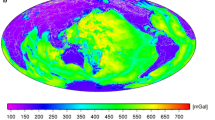Abstract
We compile the global model of the upper mantle lateral density structure with a 2×2 arc-deg spatial resolution using the values of the crust-mantle density contrast estimated relative to the adopted crust density model. The combined least-squares approach based on solving Moritz’s generalization of the Vening-Meinesz inverse problem of isostasy is facilitated to estimate the crust-mantle density contrast. The global geopotential model (EGM08), the global topographic/bathymetric model (DTM2006.0) including ice-thickness data, and the global crustal model (CRUST2.0) are used to compute the isostatic gravity anomalies. The estimated upper mantle densities globally vary between 2751 and 3635 kg/m3. The minima correspond with locations of the divergent oceanic tectonic plate boundaries (along the mid-oceanic ridges). The maxima are found along the convergent tectonic plate boundaries in the Andes and Himalayas (extending under the Tibetan Plateau). A comparison of the estimated upper mantle densities with the CRUST2.0 data shows a relatively good agreement between these two models within the continental lithosphere with the differences typically within ±100 kg/m3. Much larger discrepancies found within the oceanic lithosphere are explained by the overestimated values of the CRUST2.0 upper mantle densities. Our result shows a prevailing pattern of increasing densities with the age of oceanic lithosphere which is associated with the global mantle convection process.
Similar content being viewed by others
References
Bassin, C., Laske, G., and Masters, T.G., 2000, The current limits of resolution for surface wave tomography in North America. Eos, Transactions, AGU, 81, F897.
Braitenberg, C., Wienecke, S., and Wang Y., 2006, Basement structures from satellite-derived gravity field: south China Sea ridge. Journal of Geophysical Research, 111, B05407.
Cutnell, J.D. and Kenneth, W.J., 1995, Physics, 3rd edition, Wiley, New York.
Čadek, O. and Martinec Z., 1991, Spherical harmonic expansion of the earth’s crustal thickness up to degree and order 30. Studia Geophysica et Geodaetica, 35, 151–165.
Ekholm, S., 1996, A full coverage, high-resolution, topographic model of Greenland, computed from a variety of digital elevation data. Journal of Geophysical Research, B10, 961–972.
Hinze, W.J., 2003, Bouguer reduction density, why 2.67? Geophysics, 68, 1559–1560.
Kaban, M.K., Schwintzer, P., and Tikhotsky, S.A., 1999, Global isostatic gravity model of the Earth. Geophysical Journal International, 136, 519–536.
Kaban, M.K., Schwintzer P., Artemieva, I.M., and Mooney, W.D., 2003, Density of the continental roots: compositional and thermal contributions. Earth Planetary Science Letters, 209, 53–69.
Kaban, M.K., Schwintzer, P., and Reigber, Ch., 2004, A new isostatic model of the lithosphere and gravity field. Journal of Geodesy, 78, 368–385.
Lythe, M.B., Vaughan, D.G., and BEDMAP consortium, 2001, BEDMAP; a new ice thickness and subglacial topographic model of Antarctica. Journal of Geophysical Research, B, Solid Earth Planets, 106, 11,335–11,351.
Meier, U., Curtis A., and Trampert, J., 2007, Global crustal thickness from neural network inversion of surface wave data. Geophysical Journal International, 169, 706–722.
Mooney, W.D., Laske, G., and Masters, T.G., 1998, CRUST 5.1: a global crustal model at 5×5 deg. Journal of Geophysical Research, 103, 727–747.
Müller, R.D., Sdrolias, M., Gaina, C., and Roest, W.R., 2008, Age, spreading rates and spreading symmetry of the world’s ocean crust. Geochemistry, Geophysics, Geosystems, 9, Q04006.
Nataf, H.C. and Ricard, Y., 1996, 3SMAC: An a priori tomographic model of the upper mantle based on geophysical modeling. Physics of the Earth and Planetary Interiors, 95, 101–122.
Pavlis, N.K., Factor, J.K., and Holmes, S.A., 2007, Terrain-Related Gravimetric Quantities Computed for the Next EGM. In: Kiliçoglu, A. and Forsberg, R. (eds.), Gravity Field of the Earth. Proceedings of the 1st International Symposium of the International Gravity Field Service (IGFS), Harita Dergisi, Special Issue No. 18, General Command of Mapping, Ankara, Turkey.
Pavlis, N.K., Holmes, S.A., Kenyon, S.C., and Factor, J.K., 2012, The development and evaluation of the Earth Gravitational Model 2008 (EGM2008). Journal of Geophysical Research — Solid Earth, 117, B04406.
Shapiro, N.M. and Ritzwoller, M.H., 2002, Monte-Carlo inversion for a global shear-velocity model of the crust and upper mantle. Geophysical Journal International, 151, 88–105.
Sjöberg, L.E., 2009, Solving Vening Meinesz-Moritz Inverse Problem in Isostasy. Geophysical Journal International, 179, 1527–1536.
Sjöberg, L.E. and Bagherbandi M., 2011, A Method of Estimating the Moho Density Contrast with A Tentative Application by EGM08 and CRUST2.0. Acta Geophysica, 58, 1–24.
Soller, D.R., Richard, D.R., and Richard, D.B., 1982, A new global crustal thickness map. Tectonics, 1, 145–149.
Tenzer, R., Hamayun and Vajda, P., 2009, Global maps of the CRUST2.0 crustal components stripped gravity disturbances. Journal of Geophysical Research, Solid Earth, 114, 05408.
Tenzer, R., Gladkikh, V., Vajda, P., and Novák, P., 2012a, Spatial and spectral analysis of refined gravity data for modelling the crustmantle interface and mantle-lithosphere structure. Surveys in Geophysics, 33, 817–839.
Tenzer, R., Bagherbandi, M., and Vajda, P., 2012b, Depth-dependant density change within the continental upper mantle. Contributions to Geophysics and Geodesy 42, 1–13
Vening-Meinesz, F.A., 1931, Une nouvelle méthode pour la réduction isostatique régionale de l’intensité de la pesanteur. Bulletin Geodesique, 29, 33–51.
Vajda, P., Vaníèek, P., Novák, P., Tenzer, R., and Ellmann, A., 2007, Secondary indirect effects in gravity anomaly data inversion or interpretation. Journal Geophysical Research, Solid Earth, 112, B06411.
Watts, A.B., 2001, Isostasy and Flexure of the Lithosphere. Cambridge University Press, Cambridge, 458 p.
Wienecke, S., Braitenberg, C., and Götze, H.-J., 2007, A new analytical solution estimating the flexural rigidity in the Central Andes. Geophysical Journal International, 169, 789–794.
Author information
Authors and Affiliations
Corresponding author
Rights and permissions
About this article
Cite this article
Tenzer, R., Bagherbandi, M. & Vajda, P. Global model of the upper mantle lateral density structure based on combining seismic and isostatic models. Geosci J 17, 65–73 (2013). https://doi.org/10.1007/s12303-013-0009-z
Received:
Accepted:
Published:
Issue Date:
DOI: https://doi.org/10.1007/s12303-013-0009-z



